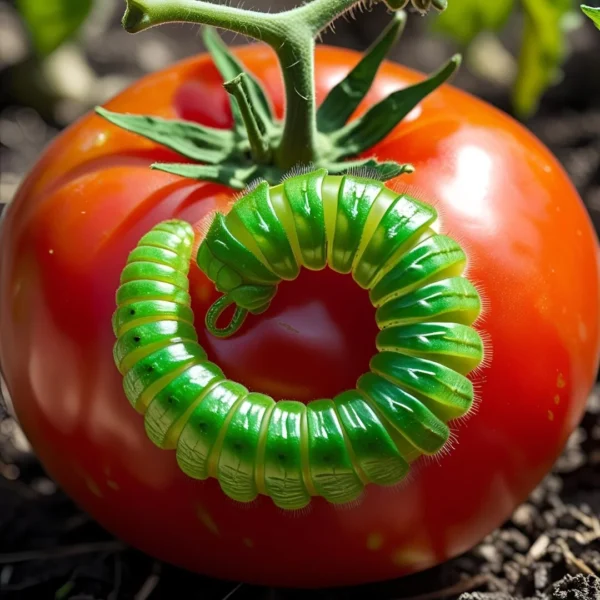Tomato hornworms are one of the most notorious pests for gardeners growing tomatoes, peppers, and related plants. These large, green caterpillars can seriously damage plants by eating foliage, stems, and fruit very quickly, often before the gardener even notices the infestation. Removing or controlling tomato hornworms naturally helps protect crops without harsh pesticides, supports beneficial insects, and maintains a healthier garden ecosystem. This comprehensive guide provides easy, proven natural strategies to identify, manage, and eradicate tomato hornworms and defend your vegetable garden effectively.

Understanding Tomato Hornworms
Tomato hornworms (Manduca quinquemaculata) are the larvae stage of the five-spotted hawk moth, named for the horn-like projection on their rear. They are bright green with white and black markings and blend well with tomato leaves. A close relative, the tobacco hornworm (Manduca sexta), also targets similar plants.
These caterpillars grow rapidly over 3-4 weeks, consuming large amounts of leaf tissue and often decimating plant health. If left unchecked, they can stunt growth, reduce yields, and leave plants vulnerable to disease.groworganic+1
1. Handpicking: The Most Effective Natural Control
-
Inspect plants daily, especially the undersides of leaves and stems.
-
Remove hornworms manually and drop them into a bucket of soapy water to kill them.
-
Use gloves if squeamish; hornworms do not sting or bite but are large and wriggly.
-
Evening inspections with a flashlight are often most productive since hornworms feed at night.
For small to moderate gardens, handpicking remains the fastest and safest way to reduce infestation naturally.gardendesign+2
2. Encourage Beneficial Insects and Parasitic Wasps
Biological control is powerful and sustainable.
-
Parasitic braconid wasps (family Braconidae) lay eggs on hornworms, which hatch inside and consume the caterpillar from within. Parasitized hornworms will have small white pupal cocoons on their backs. Leave these hornworms on the plants to maximize natural control.groworganic+1
-
Attract predatory insects such as lacewing larvae, ladybugs, and predatory stink bugs by planting nectar-rich flowers like dill, fennel, yarrow, and marigold near tomatoes.
-
Avoid broad-spectrum insecticides that kill these beneficial helpers.reddit+2
3. Companion Planting to Deter Hornworms
Certain plants repel tomato hornworms or divert pests:
-
Basil: Planted next to tomatoes, it deters hornworms and enhances tomato flavor.
-
Marigold: The strong scent confuses the moths that lay hornworm eggs.
-
Dill and Oregano: Both attract beneficial insects and repel pests.
-
Planting these herbs and flowers in or near your tomato patch creates natural pest resistance.rootsandrefuge+2
4. Use Bacillus thuringiensis (Bt) as an Organic Insecticide
-
Bt is a naturally occurring soil bacterium that releases toxins fatal to caterpillars.
-
Only affects moth and butterfly larvae; safe for humans, pets, and pollinators.
-
Apply Bt spray early when hornworms are small for best results.
-
Repeat application every 7–10 days until control is achieved.
-
Always wash tomatoes before eating after Bt use, though it is approved for organic gardening and safe with proper use.gardendesign
5. Use Homemade Natural Sprays
-
Soap sprays made with diluted liquid dish soap disrupt hornworm respiratory systems.
-
Garlic or hot pepper sprays make plants less palatable.
-
Spray at dusk to reduce bee exposure.
-
Test sprays on small plant parts first to check for leaf damage.youtubereddit
6. Remove Crop Debris and Rotate Crops
-
Till or remove tomato and nightshade plant debris after harvest to reduce overwintering pupae in soil.
-
Rotate tomatoes, peppers, and eggplant with unrelated crops to break pest cycles.
-
Clean practices minimize future hornworm outbreaks.toxicfreenc+1
7. Use Row Covers to Prevent Egg Laying
-
Cover young tomato plants with fine mesh row covers early in the season.
-
This physical barrier prevents female moths from laying eggs on leaves.
-
Remove covers once plants flower to allow pollination but continue monitoring.rootsandrefuge+1
8. Maintain Plant Health to Resist Damage
-
Healthy, well-watered plants will better tolerate some leaf loss.
-
Balanced fertilization improves plant vigor and recoverability.
-
Stressed plants are more attractive and vulnerable to hornworms.toxicfreenc
9. Regular Monitoring and Early Action
-
Check plants routinely for signs of feeding damage—irregular chewed leaves, dark green droppings (frass), and holes in fruit.
-
Early detection means easier control and less crop loss.
-
Use flashlight inspections at night to spot active hornworms.groworganic+1
How to Identify Tomato Hornworms
-
Bright green caterpillars up to 4 inches long.
-
Diagonal white stripes along sides with black spots.
-
Horn-like projection at rear, harmless but distinctive.
-
Often found on underside of tomato leaves and stems.
-
Look for chewed leaves and greenish droppings near feeding sites.
Natural Lifecycle Advantage
Understanding hornworm biology helps:
-
After feeding for weeks, hornworms burrow into soil and pupate.
-
Knowing this assists timing control methods and preventing next season’s outbreak.
-
Protecting beneficial parasitic wasps ensures ongoing natural management.
Conclusion
Tomato hornworms can devastate tomato, pepper, and nightshade crops quickly but controlling them naturally is achievable. Through vigilant monitoring, handpicking, encouraging beneficial insects and companion plants, using organic sprays like Bt, and maintaining garden hygiene and plant health, gardeners can defend their crops without resorting to harsh chemicals. Early intervention and an integrated approach are the keys to a healthy, productive vegetable garden free from hornworm damage season after season.
References:
Tomato hornworms are notorious garden pests known for quickly defoliating tomato plants and related crops like peppers and eggplants. Controlling them naturally is the safest and most environmentally friendly approach to protecting your garden from serious damage. This comprehensive article covers the top easy and effective ways to get rid of tomato hornworms without harmful chemicals, encouraging healthy crops and supporting beneficial insects.reddit+5
What Are Tomato Hornworms?
Tomato hornworms (Manduca quinquemaculata) are large green caterpillars that feed voraciously on tomato foliage, stems, and even fruit. They are the larvae stage of the five-spotted hawk moth and grow several inches long, camouflaged perfectly with the host plants. Left unchecked, hornworms can defoliate tomato plants within days and reduce yields significantly.
1. Handpicking – The First Line of Defense
-
Inspect tomato plants regularly, focusing on the undersides of leaves and stems where hornworms hide.
-
Use gloves if desired and manually remove the caterpillars.
-
Drop them into a bucket of soapy water to kill them safely.
-
Nighttime inspections with a flashlight help spot hornworms since they often feed in the dark.
This method is highly effective for small to medium gardens and immediately removes the threat without chemicals.
2. Attract Beneficial Insects and Parasitic Wasps
Certain insects naturally suppress hornworm populations:
-
Braconid wasps lay eggs inside hornworms. The larvae consume the pest from within and pupate on its back, visible as small white cocoons. Leave these parasitized hornworms alive or relocated to encourage biological control.
-
Ladybugs and lacewings prey on hornworm eggs and young larvae.
-
Planting nectar-rich flowering plants such as dill, fennel, yarrow, and marigold promotes populations of these beneficial insects.
Avoid broad-spectrum insecticides that kill beneficial predators.
3. Companion Planting to Repel Hornworms
Some plants naturally deter tomato hornworms when grown alongside tomatoes:
-
Basil is believed to repel hornworms and also improves tomato flavor.
-
Marigolds emit strong scents that deter pests, including moths that lay hornworm eggs.
-
Dill and oregano attract natural predators and confuse pests.
Interplanting these herbs and flowers helps create a balanced garden defense.
4. Use Bacillus thuringiensis (Bt)
Bt is a naturally occurring soil bacterium used as an organic insecticide:
-
It produces toxins that paralyze caterpillar digestive systems.
-
Must be applied on leaves before caterpillars reach two inches long.
-
Safe for humans, pets, and beneficial insects.
-
Reapplication every 5-7 days is necessary until control is achieved.
Bt can be found in garden centers under various brand names labeled for caterpillar control.
5. Homemade Natural Sprays
-
A mild solution of dish soap and water sprayed on plants can suffocate or deter hornworms.
-
Garlic or hot pepper sprays act as repellents.
-
Apply these in the evening to avoid harming pollinators.
-
Always test homemade sprays on a few leaves to check for damage.
6. Crop Rotation and Clean Gardening
-
Rotate tomato and other nightshade crops yearly to disrupt hornworm life cycles.
-
Remove tomato plant debris post-harvest to eliminate overwintering pupae.
-
Keep compost piles and garden clean to discourage pest buildup.
7. Row Covers
-
Lightweight fabric row covers placed over young plants prevent moths from laying eggs on tomato foliage.
-
Row covers should be removed during flowering to allow pollination if tomatoes are not self-pollinating.
-
Useful for starting tomatoes early and protecting seedlings from early infestations.
8. Plant Vigorous, Healthy Crops
-
Strong, well-watered, and fertilized plants better tolerate some damage.
-
Avoid excessive nitrogen fertilizers which promote tender growth attractive to pests.
-
Maintain soil health with organic matter and balanced nutrients.
9. Monitor and Act Quickly
-
Check plants morning and evening for feeding damage, frass (droppings), and watching for eggs on leaves.
-
Removing small caterpillars early prevents population explosion.
-
Use a flashlight at night for thorough inspection.
Conclusion
Getting rid of tomato hornworms naturally combines attentive cultural practices, biological control, manual removal, and targeted organic treatments. Handpicking and encouraging beneficial insects should be your first approach, supplemented by companion planting and organic sprays when needed. Protect plants with row covers and maintain healthy growing conditions. By integrating these proven strategies, gardeners enjoy healthier crops protected from these voracious pests season after season.
Sources:
- https://www.groworganic.com/blogs/articles/comprehensive-guide-to-managing-tomato-hornworms-identification-impact-and-effective-control-strategies
- https://rootsandrefuge.com/how-to-get-rid-of-tomato-hornworms/
- https://www.gardendesign.com/how-to/tomato-hornworm.html
- https://www.reddit.com/r/gardening/comments/1at865i/best_ways_to_naturally_avoid_hornworms_and/
- https://toxicfreenc.org/wp-content/uploads/2016/07/Vine-Borers.pdf
- https://www.youtube.com/watch?v=AvYQYAV33ro
- https://www.reddit.com/r/gardening/comments/vtxp1j/any_home_remedies_for_hornworms/
- https://www.growveg.com/guides/organic-tomato-hornworm-control/






